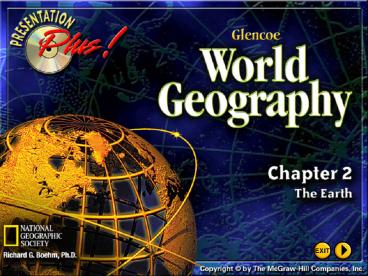Splash Screen - PowerPoint PPT Presentation
Title:
Splash Screen
Description:
It releases 80 percent of the heat generated from the earth s interior. Section 2-8 Section 2-12 ... and produces earthquakes ... deep inside the earth blast ... – PowerPoint PPT presentation
Number of Views:736
Avg rating:3.0/5.0
Title: Splash Screen
1
Splash Screen
2
Intro 1
3
Section 1-6
Our Solar System
The sun is at the center of our solar system. ?
- At least nine planets orbit our sun. ?
- What are they?
(pages 3335)
Click the mouse button or press the Space Bar to
display the information.
4
Section 1-7
- Mercury, Venus, Earth, and Mars
- Farther from the sun are the gas giant planets
- Jupiter, Saturn, Uranus, and Neptune.
- Pluto, the exception among the planets, is a ball
of ice and rock.
(pages 3335)
Click the mouse button or press the Space Bar to
display the information.
5
Section 1-10
Getting to Know Earth
- The surface is about 30 land
- and about 70 water.
- The atmosphere is about
- 78 nitrogen,
- 21 oxygen,
- and 1 other gases, such as argon.
?
(pages 3536)
Click the mouse button or press the Space Bar to
display the information.
6
Section 1-14
Earths Heights and Depths
- The highest point on Earth is the summit of Mount
Everest at 29,035 feet (8,852 m) above sea level.
- Earths lowest point of dry land is on the shore
of the Dead Sea at 1,349 feet (411 m) below sea
level.
(page 36)
Click the mouse button or press the Space Bar to
display the information.
7
- The deepest known level of the ocean floor is the
Mariana Trench at 35,827 feet (10,923 m) below
sea level.
8
Section 2-6
Earths Structure
- A Layered Planet The earth is composed of three
layers the core, the mantle, and the crust.
- The inner core is about 4,000 miles (about 6,430
km) below the surface. - The outer core is about 1,400 miles (about 2,250
km) thick.
(pages 3739)
Click the mouse button or press the Space Bar to
display the information.
9
- Both are made of iron and nickel.
- The mantle is made of hot, dense rock.
- It releases 80 percent of the heat generated from
the earths interior.
10
Section 2-8
- Many scientists believe that all the continents
once were joined and have broken apart and
drifted. This theory is called continental drift.
- Plates move gradually. As they move, they come
together and pull apart. - This movement pushes up mountains, creates
volcanoes, and produces earthquakes. - These activities are called plate tectonics.
(pages 3739)
Click the mouse button or press the Space Bar to
display the information.
11
Section 2-12
Internal Forces of Change
- Sudden, violent movements along the fault lines
are called earthquakes.
- The Ring of Fire is a zone of earthquake and
volcanic activity surrounding the Pacific Ocean. - Cities in this area, like San Francisco and Los
Angeles, are prone to severe earthquakes.
(pages 3941)
Click the mouse button or press the Space Bar to
display the information.
12
Section 2-13
- Volcanoes are mountains formed by magma that has
broken through the earths crust.
- Volcanoes often rise along plate boundaries.
- They also occur when especially hot places deep
inside the earth blast their magma to the
surface.
(pages 3941)
Click the mouse button or press the Space Bar to
display the information.
13
Section 2-2
Forces of Change
- fold
- fault
- weathering
- erosion
- loess
- glacier
- moraine
Define these terms
- continental drift
- magma
- plate tectonics
- subduction
- accretion
- spreading
14
Maps and Charts 1
15
Maps and Charts 2
16
Maps and Charts 3
17
Maps and Charts 4
18
Maps and Charts 5
19
Political Map Transparency
20
Daily Focus Skills Transparency 1
Click the mouse button or press the Space Bar to
display the answer.
21
Daily Focus Skills Transparency 2
Click the mouse button or press the Space Bar to
display the answer.
22
Daily Focus Skills Transparency 3
Click the mouse button or press the Space Bar to
display the answer.
23
End of Slide Show

